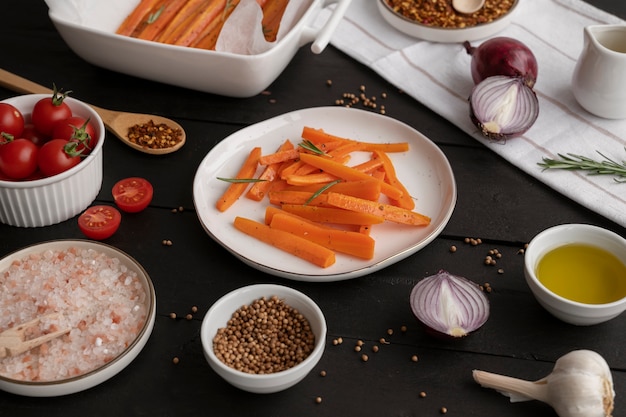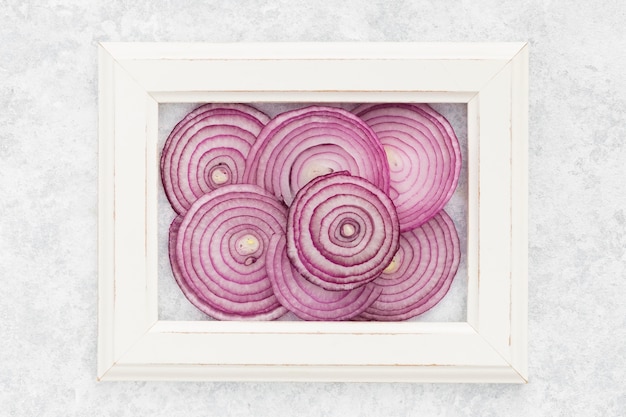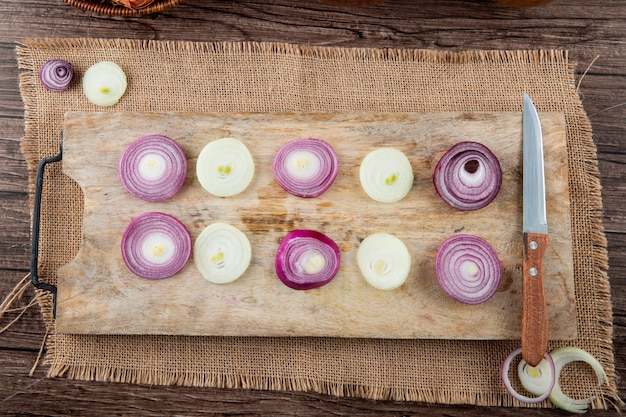(Part 1) The Onion: It All Starts Here

Choosing the Right Onions:
Let's be real, not all onions are created equal. For sauteeing, you want an onion with a good balance of sweetness and bite. My personal favourite? Yellow onions. They're incredibly versatile, hold their shape well during cooking, and have that classic onion flavour we all know and love. You can, of course, experiment with other varieties like red onions (which have a sharper flavour) or sweet white onions. But for this guide, we're going with the trusty yellow onion.
Size Matters:
Don't underestimate the importance of onion size. For sauteeing, you want medium-sized onions. Why? Because they're easier to slice evenly, and their size means they'll cook evenly without burning. Plus, they're just right for most dishes. If you're working with larger onions, simply cut them in half before slicing.
The Cut:
This is where things get interesting. There are two main ways to slice onions for sauteeing, each with its own distinct outcome:
- Thinly sliced: This gives you a quick and easy cooking method, perfect for dishes where you want the onions to soften rapidly, like a stir-fry or a simple soup. Just make sure you slice them thinly and evenly, so they cook evenly and don't end up with raw bits.
- Thickly sliced: This is my go-to method for achieving those luscious, caramelized onions. You want thick slices, about 1/4 inch or a little less. Why? Because they give you a nice surface area for browning and developing those rich, sweet flavours. Imagine that deep, syrupy texture - that's what we're aiming for.
You can even combine these methods! Try thinly slicing the bottom half of the onion and then slicing the top half into thick rings. This will give you a mix of textures and flavours in your final dish, making for a more dynamic experience.
(Part 2) The Pan: Your Sauteing Partner

Choosing the right pan is crucial for perfect sauteeing. You want a pan that will distribute heat evenly and hold its temperature well. Here's what I recommend:
Cast Iron:
My absolute favourite! cast iron pans are amazing heat retainers. They get super hot and stay hot, which is perfect for achieving that beautiful browning and caramelization. Plus, they're practically indestructible. Just remember to season them properly, and they'll reward you with years of delicious cooking.
Stainless Steel:
Stainless steel is another great option. It's a classic choice for a reason. It's durable, easy to clean, and heats evenly. However, it might not hold heat as well as cast iron, so you'll need to pay a little more attention to the temperature and adjust accordingly.
Non-Stick:
For those who prefer less mess, a non-stick pan can be a good choice. It will prevent sticking and make cleanup a breeze. Just remember that non-stick pans can lose their non-stick properties over time. So, treat them with care and avoid using metal utensils to prevent scratching.
(Part 3) The Fat: Fueling the Flavour

Okay, so you have your onions and your pan. Now it's time to talk about the fat.
The Oil:
The type of oil you use will significantly impact the flavour of your sauteed onions. Here are my top picks:
- Olive Oil: A classic choice, olive oil adds a beautiful fruity flavour to your onions. It's also a healthier option, packed with antioxidants.
- avocado oil: Another healthy choice with a high smoke point, which means it can withstand higher temperatures without burning. This is especially important when achieving that deep caramelization.
- Butter: If you want that extra richness, butter is a fantastic option. Just remember that it has a lower smoke point than olive oil or avocado oil, so be careful not to burn it. You can also try a combination of butter and olive oil for a perfect balance of flavour and aroma.
The Amount:
The amount of fat you use depends on how many onions you're sauteeing and how caramelized you want them to be. As a rule of thumb, start with about 2 tablespoons of fat for a medium-sized onion. You can always add more if needed. But remember, a little goes a long way when it comes to sauteeing onions.
(Part 4) The Temperature: Finding the Sweet Spot
This is where a lot of people go wrong. You need the right temperature to get those perfectly caramelized onions.
Medium-High Heat:
The key is to use medium-high heat. You want the pan to be hot enough to start browning the onions quickly, but not so hot that they burn. If you can hold your hand a few inches above the pan for a couple of seconds without feeling uncomfortable, you've got the right temperature.
Avoid Overcrowding:
One common mistake is overcrowding the pan. If you add too many onions, they won't cook evenly, and some of them might end up steamed instead of browned. Give your onions plenty of space to breathe in the pan. If you need to, cook them in batches.
Patience is Key:
Now comes the patience part. You're not trying to cook these onions quickly. You're letting them caramelize slowly, developing those beautiful brown tones and that intense sweetness. Think of it as a slow dance, a gentle coaxing of the onions' natural sugars to release their hidden magic.
(Part 5) The Sauteing Process: Step by Step
Time to get those onions sizzling! Here's a step-by-step guide to perfect sauteeing:
Step 1: Prep the Onions
We've already discussed choosing and slicing your onions. Make sure they're sliced evenly, whether thinly or thickly, depending on your preference. A mandoline can be a helpful tool for achieving perfectly uniform slices, but be careful to use it with caution.
Step 2: Heat the Fat
Add your chosen fat to your heated pan. You want it to be shimmering, but not smoking. This indicates that the pan is hot enough to start the sauteeing process without burning the fat.
Step 3: Add the Onions
Add your sliced onions to the pan. Spread them out in a single layer, making sure they're not overcrowded. This will ensure even cooking and prevent steaming.
Step 4: The Initial Saute
Reduce the heat to medium if necessary. Cook the onions, stirring occasionally, for about 5 minutes. They should start to soften and become translucent. You'll see the edges of the onions starting to take on a slightly golden hue.
Step 5: The Caramelization
Now comes the fun part. Turn the heat back up to medium-high. Keep stirring the onions, scraping the bottom of the pan occasionally. You want them to start browning and developing that beautiful deep golden colour. This is where the magic truly happens, as the onions release their natural sugars and begin to caramelize.
Step 6: The Sweetness
As the onions continue to cook, they'll release their natural sugars. These sugars will caramelize, giving your onions that iconic sweet flavour. You'll notice a subtle aroma of caramel filling the air, and the onions will start to soften and become almost jam-like in texture.
Step 7: Patience, Patience, Patience
This is the time to be patient. It can take anywhere from 20 to 40 minutes for your onions to reach that perfect caramelized state. Just keep stirring and scraping the pan, making sure they don't burn. This is a crucial step - don't rush it! The longer you cook the onions, the more intense their sweetness will become.
Step 8: The Perfect Finish
You'll know your onions are ready when they're deeply golden brown, almost syrupy, and have a sweet, almost jam-like consistency. If you see any burnt bits sticking to the bottom of the pan, just scrape them off and continue cooking. The key is to achieve a deep, rich caramelisation without any burnt bits.
(Part 6) The Finishing Touches: Elevate Your Sauteed Onions
Okay, you've got your perfectly sauteed onions. But why stop there? Here are some ways to take them to the next level:
Salt and Pepper:
A pinch of salt and black pepper is a must. It balances the sweetness of the onions and enhances their flavour, bringing out those savory notes.
Herbs:
Add a touch of fresh herbs, like thyme, rosemary, or parsley. They'll give your onions an extra dimension of flavour, adding a touch of freshness and complexity.
Wine:
A splash of wine, like white wine or red wine, can add a depth of flavour and richness. Just deglaze the pan after cooking the onions, scraping up any caramelized bits that have stuck to the bottom. The wine will create a delicious sauce that can be used to enhance the final dish.
Sugar:
If you want your onions extra sweet, add a pinch of sugar towards the end of cooking. The sugar will caramelize further, adding a deeper, more intense sweetness to the onions.
Balsamic Vinegar:
A drizzle of balsamic vinegar adds a touch of acidity and complexity, balancing the sweetness of the onions and adding a touch of tanginess.
(Part 7) Using Your Sauteed Onions: A World of Possibilities
The beauty of perfectly sauteed onions is that they're so versatile. They can be the star of a dish or a supporting player. Here are just a few ideas:
On Their Own:
Enjoy them as a simple side dish, topped with a sprinkle of salt and pepper. They're surprisingly satisfying on their own, offering a delightful burst of sweetness and savory flavour.
Soups and Stews:
Add them to your favourite soups and stews for a rich, flavourful base. They'll add depth and complexity to the broth, creating a truly satisfying meal.
pasta dishes:
Toss them with pasta, cheese, and your favourite sauce for a delicious meal. They'll add a touch of sweetness and savory depth to any pasta dish, complementing the cheese and sauce perfectly.
Burgers and Sandwiches:
Top your burgers and sandwiches with a generous helping of sauteed onions. They'll add a burst of flavour and texture, taking your burgers and sandwiches to the next level.
Pizzas:
They're a classic topping for pizzas. Caramelized onions add a sweet, savory counterpoint to the cheese and tomato sauce, creating a truly delicious pizza experience.
Quiches and Tartes:
Use them as a filling for quiches and tartes. They'll add a touch of sweetness and complexity to the filling, creating a more interesting and flavourful dish.
(Part 8) Tips and Tricks: Mastering the Art
Here are some tips and tricks I've learned over the years:
Don't Overcrowd the Pan:
Give your onions plenty of space to cook evenly. If necessary, cook them in batches. Overcrowding the pan will lead to steaming instead of browning, resulting in less than ideal onions.
Stir Frequently:
Stir the onions often to prevent sticking and ensure even browning. Constant stirring is key to achieving that even caramelization.
Scrape the Bottom of the Pan:
Use a spatula to scrape the bottom of the pan occasionally. This will help release any caramelized bits that could stick and burn, creating a delicious fond that can be deglazed later.
Add a Pinch of Sugar:
If you want extra sweetness, add a pinch of sugar towards the end of cooking. The sugar will caramelize further, adding a deeper, more intense sweetness to the onions.
Don't Give Up!
It takes practice to master the art of sauteeing onions. Don't be discouraged if your first attempt isn't perfect. Keep experimenting and you'll get there! The more you saute onions, the better you'll become at it. You'll develop a feel for the right temperature, the perfect stirring technique, and the subtle cues that signal the onions are nearing perfection.
(Part 9) FAQs
Here are some frequently asked questions about sauteeing onions:
1. Can I use a microwave to saute onions?
No, a microwave won't give you the same results as sauteing on the stovetop. Microwaving will steam the onions, resulting in a soft, mushy texture. You need the heat of the stovetop to achieve that browning and caramelization that makes sauteed onions so delicious.
2. What if my onions are burning?
If your onions are starting to burn, reduce the heat immediately. Scrape off any burnt bits and continue cooking. Burnt onions will impart a bitter taste, so it's crucial to prevent them from burning.
3. Can I saute frozen onions?
You can saute frozen onions, but they won't have the same flavour as fresh onions. They will also take longer to cook and may become mushy. Fresh onions are always the best choice for sauteeing, but if you're in a pinch, frozen onions will do in a pinch.
4. How long can I store sauteed onions?
You can store sauteed onions in an airtight container in the refrigerator for up to 3 days. They'll keep their flavour and texture, making them a great addition to any meal prep or quick weeknight dish.
5. Can I use a food processor to slice onions?
Yes, a food processor can be helpful for slicing onions, especially if you're slicing a large quantity. Just be careful not to over-process them, or you'll end up with onion mush. A mandoline is a good option for slicing onions evenly, but be careful when using it.
So there you have it! Your ultimate guide to perfectly sauteed onions. Now go forth and elevate your cooking game!
Remember, practice makes perfect! The more you saute onions, the better you'll become at it. And once you've mastered the art, you'll never want to cook without them.
Happy cooking!
Everyone is watching

How to Cook Frozen Lobster Tails Perfectly: A Step-by-Step Guide
RecipesLobster. Just the word conjures up images of lavish meals, special occasions, and a taste of luxury. But let's...

Pigs in a Blanket Cooking Time: How Long to Bake for Perfect Results
RecipesAh, pigs in a blanket. Just the name conjures up images of those delightful little parcels of crispy pastry en...

Pork Fillet Cooking Time: How Long to Cook It Perfectly
RecipesPork fillet, or tenderloin as it's sometimes called, is a real favourite in our house. It's so versatile, and...

The Ultimate Guide to Cooking Delicious Frankfurters
RecipesLet's face it, we all love a good frankfurter. It's a classic, simple, and always satisfying. But let's be rea...

Wolf Meat Recipes: A Guide to Cooking Wild Game
RecipesLet's be honest, you don't see wolf meat at your local butcher shop every day. It's a bit of a wild card, but ...
